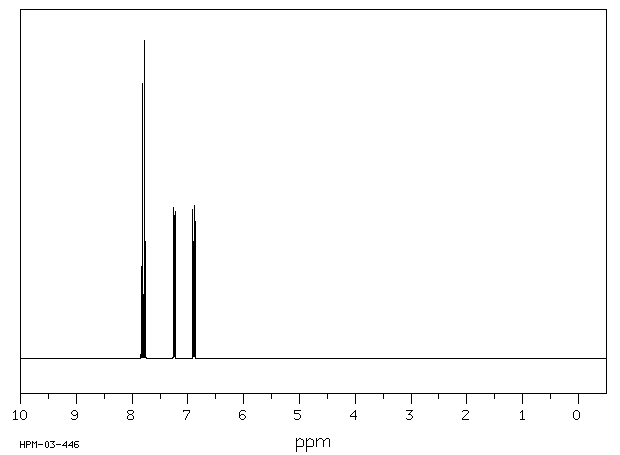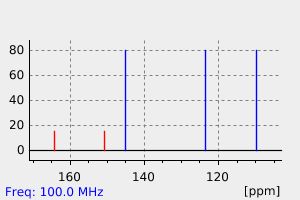2-氯-6-氟吡啶 | 20885-12-5
中文名称
2-氯-6-氟吡啶
中文别名
6-氟-2-氯吡啶
英文名称
2-chloro-6-fluoropyridine
英文别名
2-fluoro-6-chloropyridine;6-chloro-2-fluoropyridine;6-fluoro-2-chloropyridine
CAS
20885-12-5
化学式
C5H3ClFN
mdl
MFCD00077483
分子量
131.537
InChiKey
LXOHKRGLGLETIJ-UHFFFAOYSA-N
BEILSTEIN
——
EINECS
——
-
物化性质
-
计算性质
-
ADMET
-
安全信息
-
SDS
-
制备方法与用途
-
上下游信息
-
文献信息
-
表征谱图
-
同类化合物
-
相关功能分类
-
相关结构分类
物化性质
-
熔点:31.0 to 35.0 °C
-
沸点:169.2±20.0 °C(Predicted)
-
密度:1.331±0.06 g/cm3(Predicted)
-
溶解度:溶于甲醇
计算性质
-
辛醇/水分配系数(LogP):1.6
-
重原子数:8
-
可旋转键数:0
-
环数:1.0
-
sp3杂化的碳原子比例:0.0
-
拓扑面积:12.9
-
氢给体数:0
-
氢受体数:2
安全信息
-
危险等级:IRRITANT
-
危险品标志:F,Xi
-
安全说明:S26,S36
-
危险类别码:R36/37/38
-
海关编码:2933399090
-
危险性防范说明:P261,P305+P351+P338
-
危险性描述:H315,H319,H335
-
储存条件:0-10°C
SDS
Material Safety Data Sheet
Section 1. Identification of the substance
Product Name: 2-Chloro-6-fluoropyridine
Synonyms:
Section 2. Hazards identification
Harmful by inhalation, in contact with skin, and if swallowed.
H302: Harmful if swallowed
H315: Causes skin irritation
H318: Causes serious eye damage
H335: May cause respiratory irritation
P261: Avoid breathing dust/fume/gas/mist/vapours/spray
P280: Wear protective gloves/protective clothing/eye protection/face protection
P305+P351+P338: IF IN EYES: Rinse cautiously with water for several minutes. Remove contact lenses if present
and easy to do – continue rinsing
Section 3. Composition/information on ingredients.
Ingredient name: 2-Chloro-6-fluoropyridine
CAS number: 20885-12-5
Section 4. First aid measures
Skin contact: Immediately wash skin with copious amounts of water for at least 15 minutes while removing
contaminated clothing and shoes. If irritation persists, seek medical attention.
Eye contact: Immediately wash skin with copious amounts of water for at least 15 minutes. Assure adequate
flushing of the eyes by separating the eyelids with fingers. If irritation persists, seek medical
attention.
Inhalation: Remove to fresh air. In severe cases or if symptoms persist, seek medical attention.
Ingestion: Wash out mouth with copious amounts of water for at least 15 minutes. Seek medical attention.
Section 5. Fire fighting measures
In the event of a fire involving this material, alone or in combination with other materials, use dry
powder or carbon dioxide extinguishers. Protective clothing and self-contained breathing apparatus
should be worn.
Section 6. Accidental release measures
Personal precautions: Wear suitable personal protective equipment which performs satisfactorily and meets local/state/national
standards.
Respiratory precaution: Wear approved mask/respirator
Hand precaution: Wear suitable gloves/gauntlets
Skin protection: Wear suitable protective clothing
Eye protection: Wear suitable eye protection
Methods for cleaning up: Mix with sand or similar inert absorbent material, sweep up and keep in a tightly closed container
for disposal. See section 12.
Environmental precautions: Do not allow material to enter drains or water courses.
Section 7. Handling and storage
Handling: This product should be handled only by, or under the close supervision of, those properly qualified
in the handling and use of potentially hazardous chemicals, who should take into account the fire,
health and chemical hazard data given on this sheet.
Storage: Store in closed vessels.
Section 8. Exposure Controls / Personal protection
Engineering Controls: Use only in a chemical fume hood.
Personal protective equipment: Wear laboratory clothing, chemical-resistant gloves and safety goggles.
General hydiene measures: Wash thoroughly after handling. Wash contaminated clothing before reuse.
Section 9. Physical and chemical properties
Not specified
Appearance:
Boiling point: No data
Melting point: No data
Flash point: No data
Density: No data
Molecular formula: C5H3ClFN
Molecular weight: 131.5
Section 10. Stability and reactivity
Conditions to avoid: Heat, flames and sparks.
Materials to avoid: Oxidizing agents.
Possible hazardous combustion products: Carbon monoxide, nitrogen oxides, hydrogen chloride, hydrogen fluoride.
Section 11. Toxicological information
No data.
Section 12. Ecological information
No data.
Section 13. Disposal consideration
Arrange disposal as special waste, by licensed disposal company, in consultation with local waste
disposal authority, in accordance with national and regional regulations.
Section 14. Transportation information
Non-harzardous for air and ground transportation.
Section 15. Regulatory information
No chemicals in this material are subject to the reporting requirements of SARA Title III, Section
302, or have known CAS numbers that exceed the threshold reporting levels established by SARA
Title III, Section 313.
SECTION 16 - ADDITIONAL INFORMATION
N/A
Section 1. Identification of the substance
Product Name: 2-Chloro-6-fluoropyridine
Synonyms:
Section 2. Hazards identification
Harmful by inhalation, in contact with skin, and if swallowed.
H302: Harmful if swallowed
H315: Causes skin irritation
H318: Causes serious eye damage
H335: May cause respiratory irritation
P261: Avoid breathing dust/fume/gas/mist/vapours/spray
P280: Wear protective gloves/protective clothing/eye protection/face protection
P305+P351+P338: IF IN EYES: Rinse cautiously with water for several minutes. Remove contact lenses if present
and easy to do – continue rinsing
Section 3. Composition/information on ingredients.
Ingredient name: 2-Chloro-6-fluoropyridine
CAS number: 20885-12-5
Section 4. First aid measures
Skin contact: Immediately wash skin with copious amounts of water for at least 15 minutes while removing
contaminated clothing and shoes. If irritation persists, seek medical attention.
Eye contact: Immediately wash skin with copious amounts of water for at least 15 minutes. Assure adequate
flushing of the eyes by separating the eyelids with fingers. If irritation persists, seek medical
attention.
Inhalation: Remove to fresh air. In severe cases or if symptoms persist, seek medical attention.
Ingestion: Wash out mouth with copious amounts of water for at least 15 minutes. Seek medical attention.
Section 5. Fire fighting measures
In the event of a fire involving this material, alone or in combination with other materials, use dry
powder or carbon dioxide extinguishers. Protective clothing and self-contained breathing apparatus
should be worn.
Section 6. Accidental release measures
Personal precautions: Wear suitable personal protective equipment which performs satisfactorily and meets local/state/national
standards.
Respiratory precaution: Wear approved mask/respirator
Hand precaution: Wear suitable gloves/gauntlets
Skin protection: Wear suitable protective clothing
Eye protection: Wear suitable eye protection
Methods for cleaning up: Mix with sand or similar inert absorbent material, sweep up and keep in a tightly closed container
for disposal. See section 12.
Environmental precautions: Do not allow material to enter drains or water courses.
Section 7. Handling and storage
Handling: This product should be handled only by, or under the close supervision of, those properly qualified
in the handling and use of potentially hazardous chemicals, who should take into account the fire,
health and chemical hazard data given on this sheet.
Storage: Store in closed vessels.
Section 8. Exposure Controls / Personal protection
Engineering Controls: Use only in a chemical fume hood.
Personal protective equipment: Wear laboratory clothing, chemical-resistant gloves and safety goggles.
General hydiene measures: Wash thoroughly after handling. Wash contaminated clothing before reuse.
Section 9. Physical and chemical properties
Not specified
Appearance:
Boiling point: No data
Melting point: No data
Flash point: No data
Density: No data
Molecular formula: C5H3ClFN
Molecular weight: 131.5
Section 10. Stability and reactivity
Conditions to avoid: Heat, flames and sparks.
Materials to avoid: Oxidizing agents.
Possible hazardous combustion products: Carbon monoxide, nitrogen oxides, hydrogen chloride, hydrogen fluoride.
Section 11. Toxicological information
No data.
Section 12. Ecological information
No data.
Section 13. Disposal consideration
Arrange disposal as special waste, by licensed disposal company, in consultation with local waste
disposal authority, in accordance with national and regional regulations.
Section 14. Transportation information
Non-harzardous for air and ground transportation.
Section 15. Regulatory information
No chemicals in this material are subject to the reporting requirements of SARA Title III, Section
302, or have known CAS numbers that exceed the threshold reporting levels established by SARA
Title III, Section 313.
SECTION 16 - ADDITIONAL INFORMATION
N/A
上下游信息
-
上游原料
中文名称 英文名称 CAS号 化学式 分子量 2-氯吡啶 2-chloropyridine 109-09-1 C5H4ClN 113.546 -
下游产品
中文名称 英文名称 CAS号 化学式 分子量 2-氟-6-氯-3-羟基吡啶 6-chloro-2-fluoropyridin-3-ol 883107-68-4 C5H3ClFNO 147.536
反应信息
-
作为反应物:参考文献:名称:在Barbier条件下通过碘-锂交换反应连续流制备(杂)苄基锂。摘要:在这里,我们报告了通过使用t BuLi作为交换试剂在连续流动下进行的苄基碘化物上的碘-锂交换反应生成苄基锂。在Barbier条件下,羰基亲电试剂将所得的苄基锂物质原位捕获,从而生成苄基仲和叔醇。该流动程序进一步允许产生高反应性的杂苄基锂化合物,其在间歇条件下难以产生。无需进一步优化,就可以进行总体放大。DOI:10.1021/acs.orglett.0c01991
-
作为产物:描述:参考文献:名称:受经典胺化反应启发的吡啶和二嗪的选择性 CH 氟化摘要:氟化吡啶 将氟取代基附加到碳中心通常用于调节药物和农业化学研究中的小分子特性。然而,氟化通常需要使用腐蚀性、危险的试剂。Fier 和 Hartwig (p. 956) 提出了一种异常温和且方便的方案,用于氟化吡啶和相关含氮芳烃中与氮相邻的碳位点。该反应需要用二氟化银处理并在室温下快速进行。温和的氟化方法可以帮助生产医学研究中感兴趣的化合物。氟化杂环广泛存在于药物、农用化学品和材料中。然而,将氟结合到杂芳烃中的反应范围有限并且可能是危险的。我们提出了一种广泛适用且安全的方法,用于使用市售的氟化银 (II) 对吡啶和二嗪中的单个碳氢键进行位点选择性氟化。反应在环境温度下在 1 小时内发生,并且对氮附近的氟化具有唯一的选择性。温和的条件允许获得具有重要医学意义的化合物的氟化衍生物,以及通过随后的氟化物亲核置换制备的一系列 2-取代吡啶。机理研究表明,经典的吡啶胺化途径可适用于广泛范围的氮杂环的选择性氟化。反应在环境温度下在DOI:10.1126/science.1243759
文献信息
-
Nickel‐Catalyzed Thiolation of Aryl Halides and Heteroaryl Halides through Electrochemistry作者:Dong Liu、Hong‐Xing Ma、Ping Fang、Tian‐Sheng MeiDOI:10.1002/anie.201900956日期:2019.4Transition‐metal‐catalyzed coupling reactions are useful tools for synthesizing aryl sulfur compounds. However, conventional transition‐metal‐catalyzed thiolation of aryl bromides and chlorides typically requires the use of strong base under elevated reaction temperature. Herein, we report the first examples of nickel‐catalyzed electrochemical thiolation of aryl bromides and chlorides in the absence
-
[EN] PYRIDIN-3-YL ACETIC ACID DERIVATIVES AS INHIBITORS OF HUMAN IMMUNODEFICIENCY VIRUS REPLICATION<br/>[FR] DÉRIVÉS D'ACIDE PYRIDIN-3-YLE ACÉTIQUE UTILISÉS EN TANT QU'INHIBITEURS DE LA RÉPLICATION DU VIRUS DE L'IMMUNODÉFICIENCE HUMAINE申请人:VIIV HEALTHCARE UK NO 5 LTD公开号:WO2018127800A1公开(公告)日:2018-07-12Disclosed are compounds of Formula I, including pharmaceutically acceptable salts, pharmaceutical compositions comprising the compounds, methods for making the compounds and their use in inhibiting HIV integrase and treating those infected with HIV or AIDS. (I)公开了公式I的化合物,包括药用可接受的盐、包含这些化合物的药物组合物、制备这些化合物的方法,以及它们在抑制HIV整合酶和治疗HIV或艾滋病感染者中的用途。
-
Discovery of DS-6930, a potent selective PPARγ modulator. Part II: Lead optimization作者:Tsuyoshi Shinozuka、Tomoharu Tsukada、Kunihiko Fujii、Eri Tokumaru、Kousei Shimada、Yoshiyuki Onishi、Yumi Matsui、Satoko Wakimoto、Masanori Kuroha、Tsuneaki Ogata、Kazushi Araki、Jun Ohsumi、Ryoko Sawamura、Nobuaki Watanabe、Hideki Yamamoto、Kazunori Fujimoto、Yoshiro Tani、Makoto Mori、Jun TanakaDOI:10.1016/j.bmc.2018.09.005日期:2018.10synthesized compound (II) for the avoidance of hepatotoxicity. The replacement of the left-hand side benzene with 2-pyridine resulted in the substantial loss of potency. Because poor membrane permeability was responsible for poor potency in vitro, the adjustment of lipophilicity was examined, which resulted in the discovery of dimethyl pyridine derivative (I, DS-6930). In preclinical studies, DS-6930 demonstrated为了避免肝毒性,尝试降低先前合成的化合物(II)的亲脂性。用2-吡啶代替左手侧苯导致效力的实质损失。由于差的膜通透性导致体外效价差,因此对亲脂性的调节进行了检查,从而发现了二甲基吡啶衍生物(I,DS-6930)。在临床前研究中,DS-6930表现出较高的PPARγ激动剂效价,且血浆葡萄糖降低明显。DS-6930在体内进行毒理学评估后维持与PPARγ相关的副作用减少,并没有显示出肝毒性。辅助因子募集测定表明,显着募集了一些辅助因子,例如RIP140和PGC1,而几个典型因子并未受到影响。这种选择性辅因子募集是由于DS-6930的独特结合模式引起的。钙盐DS-6930b被认为是有效的胰岛素增敏剂,无水肿,可在T2DM患者中进行临床评估。
-
[EN] BIARYL KINASE INHIBITORS<br/>[FR] INHIBITEURS DE KINASES À BASE DE BIARYLE申请人:BRISTOL MYERS SQUIBB CO公开号:WO2017059085A1公开(公告)日:2017-04-06The present disclosure is directed to biaryl compounds of formula (I) which can inhibit AAKl (adaptor associated kinase 1), compositions comprising such compounds and their use for treating e.g. pain, Alzheimer's disease, Parkinson's disease and schizophrenia.
-
[EN] INDOLE COMPOUNDS AS ANDROGEN RECEPTOR MODULATORS<br/>[FR] COMPOSÉS INDOLIQUES UTILES EN TANT QUE MODULATEURS DU RÉCEPTEUR DES ANDROGÈNES申请人:NIDO BIOSCIENCES INC公开号:WO2022020342A1公开(公告)日:2022-01-27Provided herein are compounds of formula (V) that bind to BF3 of an androgen receptor (AR), which can modulate the AR for the treatment of Kennedy's disease.本文提供了一种公式(V)的化合物,它们与雄激素受体(AR)的BF3结合,可以调节AR以治疗肯尼迪病。
表征谱图
-
氢谱1HNMR
-
质谱MS
-
碳谱13CNMR
-
红外IR
-
拉曼Raman
-
峰位数据
-
峰位匹配
-
表征信息
同类化合物
(S)-氨氯地平-d4
(R,S)-可替宁N-氧化物-甲基-d3
(R)-(+)-2,2'',6,6''-四甲氧基-4,4''-双(二苯基膦基)-3,3''-联吡啶(1,5-环辛二烯)铑(I)四氟硼酸盐
(R)-N'-亚硝基尼古丁
(R)-DRF053二盐酸盐
(5E)-5-[(2,5-二甲基-1-吡啶-3-基-吡咯-3-基)亚甲基]-2-亚磺酰基-1,3-噻唑烷-4-酮
(5-溴-3-吡啶基)[4-(1-吡咯烷基)-1-哌啶基]甲酮
(5-氨基-6-氰基-7-甲基[1,2]噻唑并[4,5-b]吡啶-3-甲酰胺)
(2S,2'S)-(-)-[N,N'-双(2-吡啶基甲基]-2,2'-联吡咯烷双(乙腈)铁(II)六氟锑酸盐
(2S)-2-[[[9-丙-2-基-6-[(4-吡啶-2-基苯基)甲基氨基]嘌呤-2-基]氨基]丁-1-醇
(2R,2''R)-(+)-[N,N''-双(2-吡啶基甲基)]-2,2''-联吡咯烷四盐酸盐
(1'R,2'S)-尼古丁1,1'-Di-N-氧化物
黄色素-37
麦斯明-D4
麦司明
麝香吡啶
鲁非罗尼
鲁卡他胺
高氯酸N-甲基甲基吡啶正离子
高氯酸,吡啶
高奎宁酸
马来酸溴苯那敏
马来酸氯苯那敏-D6
马来酸左氨氯地平
顺式-双(异硫氰基)(2,2'-联吡啶基-4,4'-二羧基)(4,4'-二-壬基-2'-联吡啶基)钌(II)
顺式-二氯二(4-氯吡啶)铂
顺式-二(2,2'-联吡啶)二氯铬氯化物
顺式-1-(4-甲氧基苄基)-3-羟基-5-(3-吡啶)-2-吡咯烷酮
顺-双(2,2-二吡啶)二氯化钌(II) 水合物
顺-双(2,2'-二吡啶基)二氯化钌(II)二水合物
顺-二氯二(吡啶)铂(II)
顺-二(2,2'-联吡啶)二氯化钌(II)二水合物
韦德伊斯试剂
非那吡啶
非洛地平杂质C
非洛地平
非戈替尼
非布索坦杂质66
非尼拉朵
非尼拉敏
雷索替丁
阿雷地平
阿瑞洛莫
阿扎那韦中间体
阿培利司N-6
阿伐曲波帕杂质40
间硝苯地平
间-硝苯地平
镉,二碘四(4-甲基吡啶)-
锌,二溴二[4-吡啶羧硫代酸(2-吡啶基亚甲基)酰肼]-








